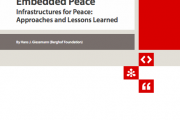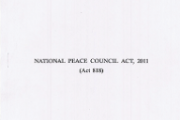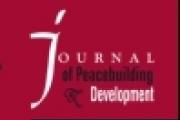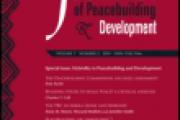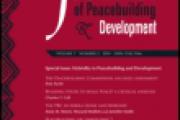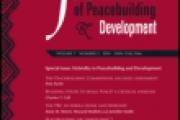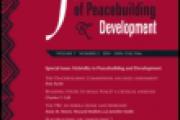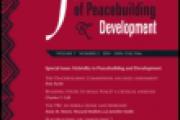Infrastructures for Peace
I4P in Practice
Malawi's National Peace Architecture
Malawi’s Peace Architecture provides a solid foundation for national ownership of and commitment to social cohesion and conflict prevention. It empowers women and youth to act as mediators and conflict monitors on the ground, and play a leading role in conflict prevention and peacebuilding.
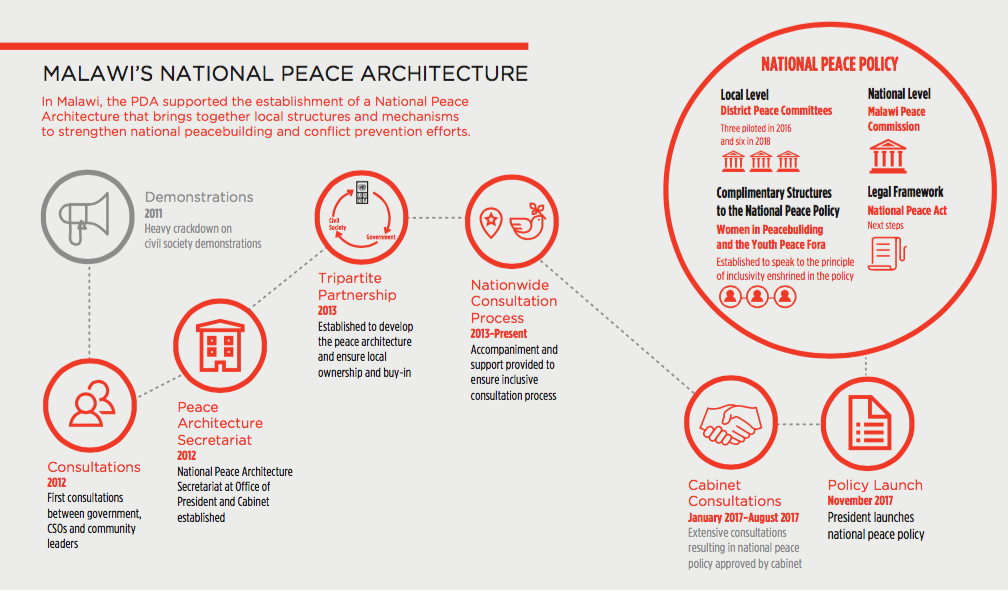
The National Peace Council in Ghana
Ghana is widely regarded as a successful case in integrating I4P into national policy. The initiative for creating peace infrastructures as part of a national policy was designed to help reconcile tensions emerging from the existence of two States within one: a traditional State controlled by tribal chiefs without formal political authority, and a modern State controlled at the local level by a district chief executive. The guiding principle behind Ghana's national I4P was to establish institutionalized structures at national, regional, and district levels, which are capable of engaging all stakeholders through dialogue facilitation, problem-solving, and reconciliation promotion. Ghana's national I4P encompasses three levels of government. It was established by decree of the Ministry of the Interior and was embedded into a legal superstructure. The National Peace Council Act of 2011 established a national I4P that consisted of a National Peace Committee, regional and district peace councils and as an innovative element, government-affiliated peace promotion officers at the regional and district level.
South Africa's I4P
South Africa was the first country that developed a comprehensive national framework for peacebuilding that resulted in a national I4P. Following the National Peace Accord in 1991, a three-layered I4P was created, which comprised the following main components: National Peace Committee, National Peace Secretariat, Regional Peace Committees, Local Peace Committees and Peace Monitors (Odendaal 2014, p.75). The South African I4P was truly innovative and ground-breaking given that no rudimentary structures existed, accountability and confidence were not guaranteed by the state, and no legal or procedural structures were in place to lay the ground for a new social contract. Despite this, the I4P were developed based on joint and inclusive ownership. The peace committees were established by local communities, which provided them with sufficient public legitimacy and political support. The incorporation of police representatives into the peace committees helped to strengthen accountability and local buy-in, as well as readiness to cooperate with the police corps. The peace committees in South Africa aimed to address emerging outbreaks of violence through inclusive dialogue forums at the community level. The communities involved immediately understood the benefit and importance of collaboration and joint problem solving. The peace process in South Africa was coordinated at all levels, with distinct but complementary roles for each track, and a countrywide network of similar institutional structures, contributing to what is now considered by other countries a success and role model for I4P.
Insider Peacebuilders Platform Thailand
In 2011, a group of activists working on the conflict in the South of Thailand initiated a network of insider mediators, called the "Insider Peacebuilders Platform (IPP)", which is comprised of academic institutions, civil society organizations and a think-tank linked to the Parliament. The IPP is engaging committed insider peacebuilders and mediators from across the spectrum of conflict and political actors.
Without a formal mandate, the IPP has created a space for dialogue and fostered the exchange of diverse perspectives among activists and leaders from a wide spectrum of constituencies and conflict actors. Research on the Insider Peacebuilders Platform (IPP) has revealed that this initiative is becoming a promising and innovative I4P due to its inclusive approach and its resulting multi-stakeholder legitimacy and has as a result, already provided impetus for the peace process in the South.
 Photo: UNDP Nepal
Photo: UNDP Nepal
I4P in Tunisia
Following the political transition in Tunisia in 2011 several examples of nationally owned, institutionalized and non-institutionalized mechanisms were created to prevent the transition process from derailing, and to mitigate imminent threats of escalation after repeated serious political crises. Some of these mechanisms fostered consensus building and dialogue to overcome political deadlock i.e. the formation of a Consensus Committee within the Constituent Assembly and the National Dialogue initiated by the so-called Tunisian "Quartet." The Consensus Committee, which was made up of all parliamentary groups including some independents, was set up according to the principle of equal representation. The formation of this committee helped to reach a compromise on issues surrounding rights, various freedoms, and specific provisions in the draft Constitution. Initiated by four civil society organizations, the "Quartet" called for a National Dialogue in order to bring all political parties together. The Quartet managed to diffuse a tense political environment by creating a forum in which political parties could reach an agreement on key transitional processes. The major achievements of the National Dialogue include: bringing together all key political actors, with the exception of those that excluded themselves; forming a caretaker government; forming an Electoral Commission to oversee elections; agenda setting; establishing a calendar for key milestones in the transitional process; getting the parties to sign up to the agreement; and, reaching a compromise between electoral legitimacy and consensus legitimacy (Redissi, 2014). Despite many setbacks, including the assassination of political leaders, and delays in the constitutional process, Tunisia's transition demonstrated that with concerted effort, political will, and nationally-owned mechanisms for consensus-building, transition processes can pave the way for establishing a new social contract under difficult conditions.
The Ministry of Peace and Reconstruction in Nepal
Following the signing of the Comprehensive Peace Agreement in 2006, an entire set of components for I4P were established in Nepal. The Ministry of Peace and Reconstruction was formally established and mandated by the Comprehensive Peace Agreement. Though an integral element of the Nepali government administration, this institution is considered as an I4P because of its distinct role and tasks with regard to the peace process, including setting up local peace committees, managing the Nepal Peace Trust Fund, and act as a policy-maker on issues related to conflict prevention and peacebuilding. Local Peace Committees were established in almost all of the 75 districts of Nepal and were designed to provide a link between the national peace processes and the communities. Despite the comprehensive design of the Nepali I4P, the I4P did unfortunately not deliver on its mandate. The failure to establish multi-party control over the I4P – as was envisaged by the Comprehensive Peace Agreement- resulted in control being exercised over the Ministry of Peace and Reconstruction by the ruling party. Similarly, in many communities, Local Peace Committees were formed by ruling elites who were the only parties to be invited by the Ministry for Peace and Reconstruction. The peace process became more and more politicized, which hampered the readiness to compromise. In addition, a deficit of funds, administrative support, qualified staff, technical support and vetting mechanisms provided a significant challenge. Although, the Ministry for Peace and Reconstruction established its own implementation unit, greater skills and resources were required for this Unit to be effective (Odendaal 2010, 61). The concept of local peace infrastructure was "never discussed with local actors, but was designed top-down, based on political negotiation and donors' recommendations" (Bhandari 2011, 15). The Nepal case demonstrates why ownership by local civil society is integral to the success of I4P.

